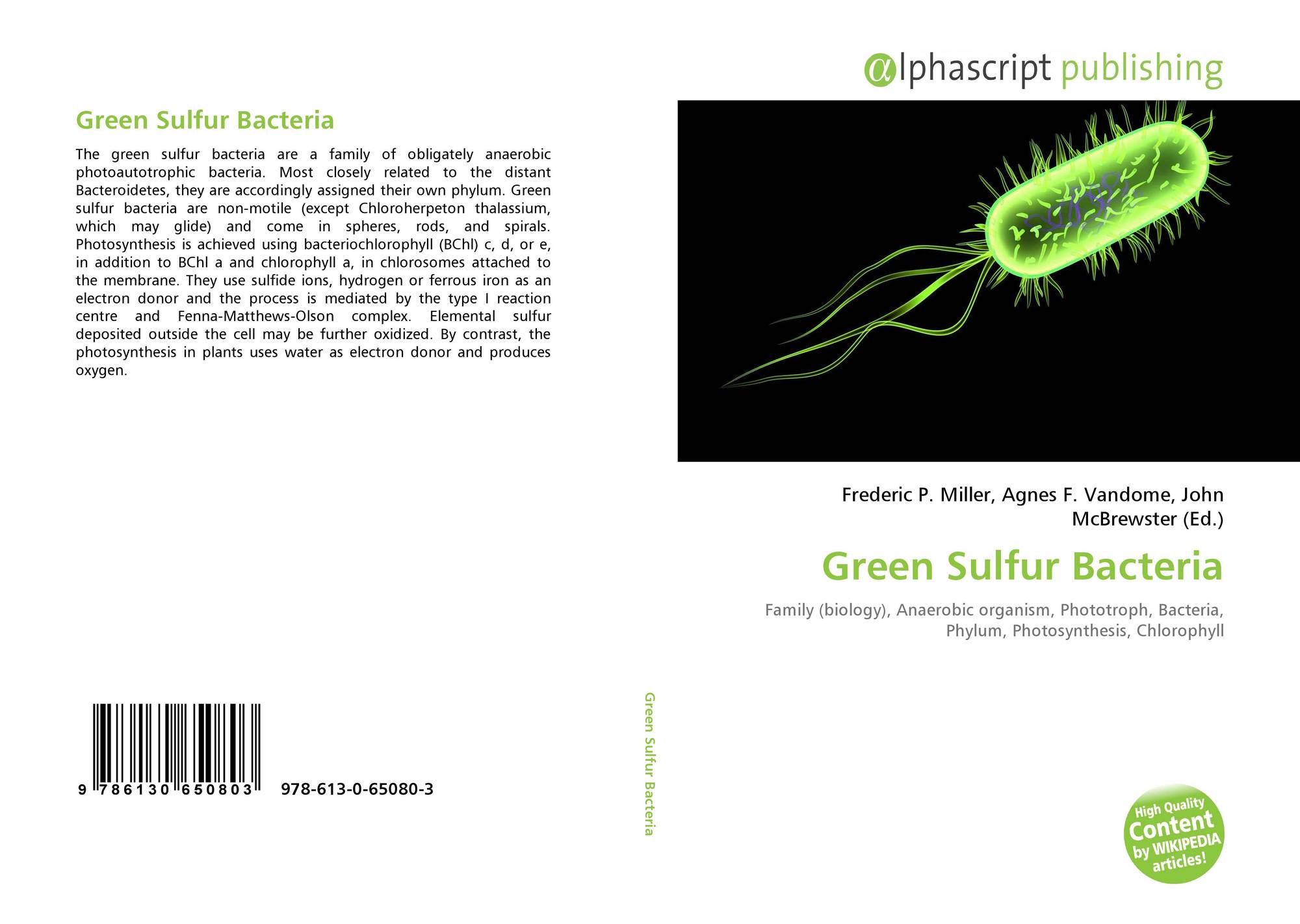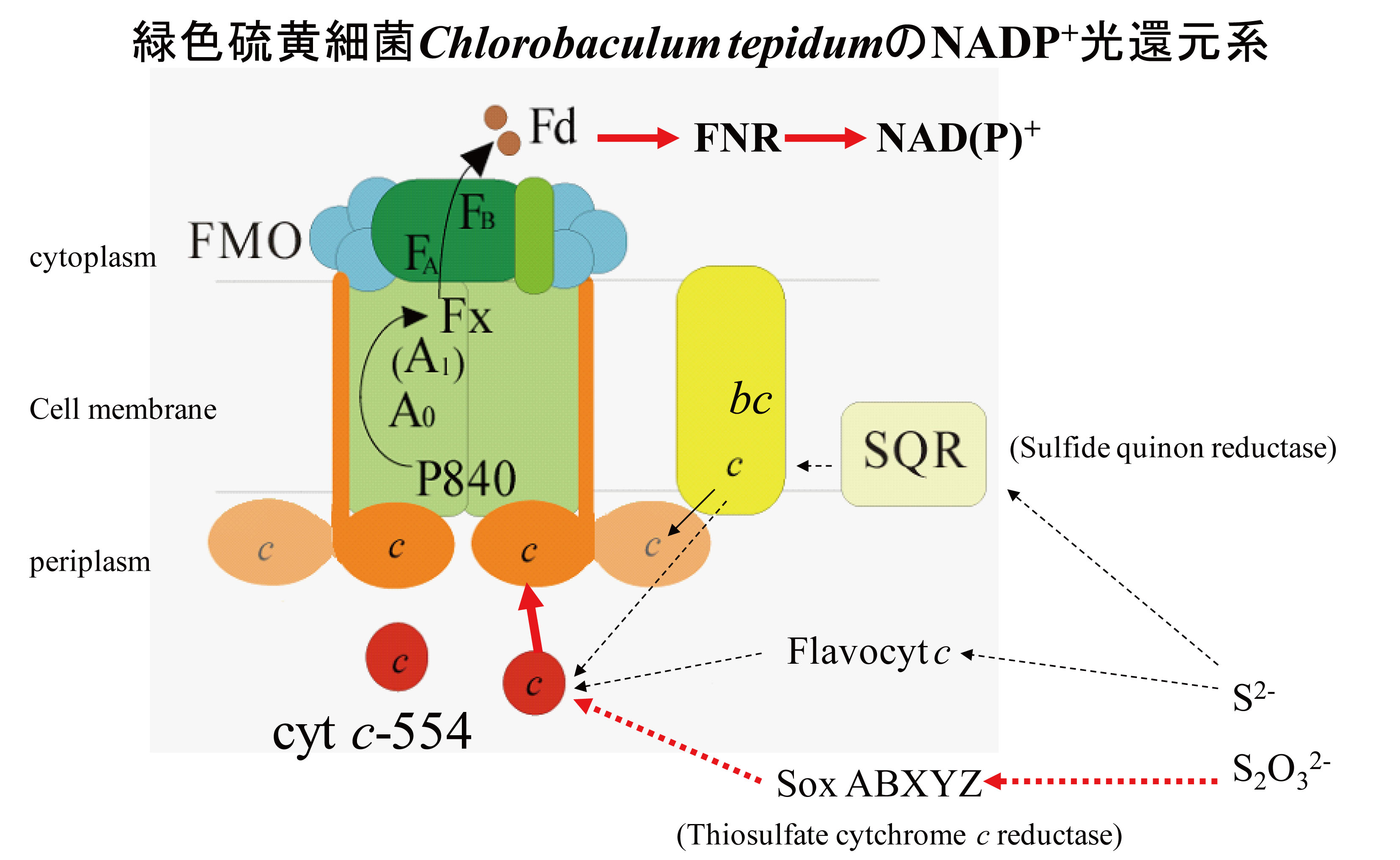Green sulfur bacteria
Green sulfur bacteria in a Winogradsky column
Green sulfur bacteria or Chlorobien called ( from Ancient Greek χλωρός, chloros - the bright green, fresh ) are unicellular, phototrophic, obligately anaerobic bacteria (domain Bacteria) with various outer shapes and without active movement. The Chlorobiaceae family forms within the bacteria a coherent and isolated group, which is why it is classified as a separate phylum in biological systematics.
Physiology
The representatives of the Green sulfur bacteria operate a anoxygenic photosynthesis with reduced sulfur compounds such as hydrogen sulfide (H2S) and thiosulfate ( S2O32 ), or with elemental sulfur as the reductant. Some species are phototroph to oxidize also capable of hydrogen or ferrous iron (Fe (II)). In the oxidation of hydrogen sulfide first is oxidized only to elemental sulfur which is deposited outside the cells. This sulfur is very good microscopically recognizable as brightly shining balls that cling to the bacterial cells from the outside. At the onset of hydrogen sulfide deficiency then an oxidation of the deposited sulfur to sulfate. And thiosulfate, is used by only a few species, phototrophic completely oxidised to sulphate. The carbon dioxide assimilation does not work like most phototrophs via the Calvin cycle, but via the reverse citric acid cycle. Green sulfur bacteria are generally photoautotrophically, some can assimilate organic substances with the aid of light energy, but then are therefore photoheterotroph.
The photosystem of green sulfur bacteria is adjacent to the adenosine triphosphate -forming system in their cytoplasmic membrane and contains bacteriochlorophyll a antenna pigments serve as bacteriochlorophyll c, d or e, which are contained in so-called chlorosomes; are the membrane sacs that are on the inside of the cytoplasmic membrane in contact with it. The cytoplasmic membrane with part of the photosystem and the chlorosomes with another part as a functional unit.
Green sulfur bacteria are found in anoxic, hydrogen sulphide -containing waters areas. Since they can use light for photosynthesis very effective, they also occur in low-light areas, so even at a greater depth than other phototrophic organisms.
Taxonomy and Phylogeny
Traditionally, a taxonomic classification based on easily recognizable phenotypic features. Besides cell morphology was, for example, the formation of gas vesicles used to distinguish between different genera within the Chlorobiaceae. The brown Chlorobien were distinguished from the green by the different composition of their pigments chlorophyll and carotenoids. A distinction of subspecies was based on the use of thiosulfate as a photosynthetic electron donor. These classic distinguishing features, even if they still apply, do not coincide with the current molecular biological results. They have therefore for the phylogenetic taxonomy of Chlorobiaceae only minor importance. According to the current state of research, the Chlorobiaceae be divided into the genera Chlorobium, Prosthecochloris and Chlorobaculum.
The genus Chlorobium includes the Green sulfur bacteria with rod-shaped or curved rod-shaped ( vibroider ) cell shape which occur singly or in cell aggregates. Some species have gas vesicles. Under anoxic conditions and in the presence of light and reduced sulfur compounds ( such as sulfide ), or elemental sulfur, a photolithotrophes growth is possible. Thiosulfate and hydrogen can also be used by some Chlorobien. In the phototrophic oxidation of sulfide, elemental sulfur is deposited temporarily outside the cells. Sulfate is the final product in all reduced sulfur compound. In the presence of sulfide and bicarbonate simple organic substrates can be photoassimiliert. The rod- shaped species, the cell thickness (diameter ) is about 0.6 to 1.2 microns and they need for their growth no salt. The vibroiden species possess a cell thickness (diameter) of 0.3 to 0.9 microns and require low salt concentrations for growth. Vitamin B12 is required for many species within this genus.
As photosynthetic pigments bacteriochlorophyll ( BChl ) c, d or e are used. The BChl c occurs to getting together with the carotenoids Chlorobacten group, while BChl e is always associated with the carotenoids of Isorenierat group. Previously described species: Chlorobium limicola, Chlorobium ferrooxidans, Chlorobium clathratiforme phaeobacteroides, Chlorobium, Chlorobium phaeovibrioides, Chlorobium luteolum
The results summarized in the genus Prosthecochloris bacterial species are spherical to ovoid ( ovoid ) or rod- shaped. There are individual cells, which are capable of forming straight Prosthecen. The cells reach a diameter of 0.5 to 0.7 microns and a cell length of 0.5 to 1.2 microns. Photolithotrophes growth occurs under anoxic conditions in the light and with reduced sulfur compounds (such as sulfide ) or elemental sulfur. In the phototrophic oxidation of sulfide, elemental sulfur is temporarily formed outside the cells. The end product is always sulfate. As photosynthetic pigments serve BChl c and BChl d or e BChl c and d is accompanied by carotenoids Chlorobacten group. BChl e, however, of the Isorenierat group. Salt and vitamin B12 is an obligatory growth factor for these representatives of the Green sulfur bacteria. Species described to date are: Prosthecochloris aestuarii and Prosthecochloris vibrioformis.
Under the genus Chlorobaculum vibroide or rod-shaped representatives are detected, some of which contain gas vesicles. The cell size is from 0.3 to 1.1 microns. Vitamin B12 is required for many species. Photolithotrophes growth occurs under anoxic conditions in the light and with reduced sulfur compounds (such as sulfide and thiosulfate ) or elemental sulfur. In the phototrophic oxidation of sulfide, elemental sulfur is temporarily formed outside the cells. The end product is always sulfate. In the presence of sulfide and organic substrates can be simple bicarbonate photoassimiliert. Photosynthetic pigments BChl c and BChl d or e, the green Chlorobaculum species contain carotenoids Chlorobacten group, the brown Chlorobaculum species, however, the Isorenierat the group. So far, the following species are described: Chlorobaculum tepidum, Chlorobaculum limnaeum, Chlorobaculum thiosulfatiphilum, Chlorobaculum parvum and Chlorobaculum chlorovibrioides.
Some Green sulfur bacteria form aggregates with chemoheterotrophen bacteria that are beneficial for both partners ( mutualism ), so-called consortia. Several individuals of Greens To have a long flagellated heterotrophic bacteria arranged sulfur bacteria: An example of this is " Chlorochromatium aggregatum " (since there are two different creatures, this designation is not a taxon ). Wherein the heterotrophic organism is a bacterium sulfatreduzierendes which reduces sulfate to sulfide.










